
Home - Search - Browse - Alphabetic Index: 0- 1- 2- 3- 4- 5- 6- 7- 8- 9
A- B- C- D- E- F- G- H- I- J- K- L- M- N- O- P- Q- R- S- T- U- V- W- X- Y- Z
Space Cadet
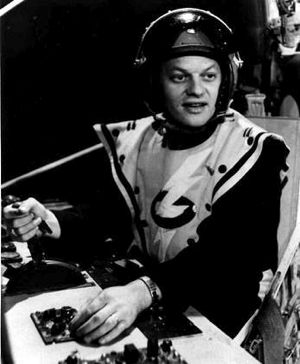 Captain Satellite Credit: Courtesy Bob March. |
Baby boomers were just becoming aware of the world as the space age began. Those of us of a certain age were too young to participate in the events of the time, but what a wonderful future we thought lay ahead!
Before Sputnik there was the Jet Age. The preschooler was shown the seemingly limitless future for aviation. Every week the newscasts spoke of new jet-planes and rocket-planes, flying higher, faster, farther. On television Jet Jackson (aka Captain Midnight) flew his rocket plane from a secret mountain headquarters. Open house days at air bases featured sleek Nike missiles and F-86 Saber fighters. Navy blimps, silver and quiet, still flew overhead in those days.
The promise of space became reality with Sputnik. A few years later the much more visible Echo balloon was launched. The newspapers would give instructions on when and where to look for the new manmade moons that passed overhead. I remember going out in the back yard with my father and seeing the satellites smoothly and silently pass by overhead. What a wonderment that men could build such things. Seeing it with your own eyes proved the reality of it.
As one began to read, books catered to the expected future. You Will Go to the Moon described in first-grade words how it would be to visit a moon base. At carnivals there were actual gleaming silver rockets you could ride to space and back. You would buy your ticket, go inside the closed cabin, and feel the rocket pitch and roll as a view-screen showed you the ascent. When I got off the ride, just a little suspicious, I asked my mom if we had really taken off. "Of course" she answered… (This seems to be one of several rocket rides touring the United States at the time but doesn't match any of them precisely.
Maybe it was just a ride, you figured, but having your own play-rocketship was nearly as cool as flying in a real one. On the backs of comic books Kraft Marshmallows offered one kid somewhere the chance to win just such a full-size simulator. It was complete with four control panels with seats and space suits for the crew, and a projector that would show the flight on a forward view screen. I read the ad over and over for years after the contest was over, wondering if it was really true and what lucky kid got the rocket (the Aerojet-designed simulator was delivered to a girl in Saint Louis. She donated it to an elementary school. After some time it was mounted on a pillar outside of the school, then disappeared sometimes in the 1960's).
In the absence of such elaborate mock-ups we were forced to make our own out of cardboard. The Mercury program had started and it was easy to imagine a large cardboard shipping carton as a space capsule. A black felt tip pen and scissors allowed us to make our own control panels out of cardboard with elaborate controls and gauges drawn with felt-tip pens. For Christmas we would get our own astronaut jump suits and space helmets, complete with wax-paper-membrane microphone that produced an appropriately scratchy voice. In our space get-up, in the capsule, friends would provide appropriate launch, pitch, and roll effects as we flew a space mission inside the carton. These were not reusable spacecraft! One carton was not good for too many missions before it lost its shape from being shoved and rolled around the yard…
On television, Captain Satellite blasted off into space every afternoon at 4 PM on 'KTVU - Channel 2'. Bob March played the erstwhile Captain. His space ship looked like an X-15, but was much bigger. The cabin was equipped with an ejection seat in front of a complicated control panel below the windshield, followed by a master computer station, and at the rear, a space lock. Kids would visit the show every day, and win a prize in the space lock contest. There was a long waiting list to get on the show, but my brother and I finally took the long drive to Oakland to be on television when I was in second grade. The reality was a disappointment! First it turned out that the Captain was a very short guy (good for working with kids, I suppose). The next let-down came when my little brother got to sit in the ejection seat and pull the throttles back at lift-off. I had to man the computer.
But it turned out it was all phony anyway! The ship didn't go into space; they just tilted the camera sideways and shook it around at lift-off! The shots of the ship in space was just an X-15 model on a black stick in a black-painted shoe-box - they rotated the black stick to make it maneuver in space! My space lock prize was a pile of Classics Comics (these were loathsome comic books based on classic literature, like Jane Eyre or whatever). My buddy ran home from school, telling his mom his best friend was on television, but when they turned on the TV all they saw was a chimpanzee! (the Captain padded out the show with low-cost rentals, in this case one of those programs where they dressed apes up in clothes and had them act out stories).
By the time we got home I had the first splitting headache of my life but a new interest in models and special effects. And what models they had back then! There were the models of what was expected to be - big winged, Von Braun-inspired boosters, space stations, and moon landers, the awesome XSL-01 nuclear Mars spacecraft, nuclear-powered supersonic transports. The real stuff was great too - sleek X-15's and B-70's, awesome collections of rockets and missiles, Mercury and Gemini capsules (the Gemini complete with the expected landing skids for the paraglider version), a complete Atlas-Mercury booster with launch pad. Over the years my skills improved - an agonizing progression from initial glue-smeared, unpainted models to finely detailed products. But what an exercise of the imagination to construct the detailed deployable solar-generator of the XSL-01 or the internal equipment of the Gemini.
Meanwhile the space age began to be reflected in more real terms on television. Captain Satellite showed a series The Space Explorers which featured awesome views of a space ship being rolled out of a huge hangar, being launched from a long ramp, with the moon and stars visible through the many windows of the expansive cockpit (little did I know that this footage was taken from a 1939 short Nazi propaganda film prophesying German exploration of the moon). Also utterly realistic was the television program Men in Space, which featured exploration of the moon by the US Air Force. The program had technical advice from Willy Ley and the US Air Force.
More engrossing than the fiction was the real thing, playing on television screens weekly at the time. This was the thick of the space race, and one cannot imagine now how exciting it was. One week the Russians would launch some tremendous new spaceship, followed by the Americans (or at least a failed attempt by the Americans). American manned launches mainly consisted of waiting, waiting, waiting as innumerable holds and problems held up the expected launches. Network science correspondents and anchors - Jules Bergman, Frank Reynolds, Walter Cronkite - would fill in the hours with endless explanations of the missions, the boosters, the capsules. There were no computer graphics or special effects, except for instructional models of the rockets and spacecraft. Any live visuals only existed for the launch itself.
By the Gemini program they had begun to get live coverage of recoveries via communications satellite. In particular I remember one great moment when the capsule (I thought it was Gemini 6, but it could have been Gemini 9) was raised to the carrier deck with the crew aboard. The commander's hatch was opened, the helmeted astronaut gave the thumbs up as the band crashed into 'Anchors Aweigh'.
By the time Mercury was over the networks became more sophisticated, providing sometimes comical reconstructions of the spacewalks. NBC used puppets with Gemini models, while CBS went for a full size simulation - a guy in a spacesuit on wires with a full-sized Gemini mock-up. There was always great confusion, since none of he Gemini space walks went according to plan, and the puppet or guy would struggle around while the network tried to guess what was really going on. The low end of visual aids came during the Gemini 8 emergency landing, when ABC used a big empty stage and moved model ships about it in an attempt to show the movement of the recovery forces toward the lost capsule. Urban legend has it that the network was deluged with callers protesting the pre-emption of Batman.
Meanwhile Martin Caidin was turning out a series of books portraying the excitement of space exploration - Marooned, No Man's World, Four Came Back. Odd numbers like Autopsy for a Cosmonaut would show up on the local book racks. Films began reflecting the space race. In You Only Live Twice James Bond fought Blofeld in his attempt to create a world war by kidnapping Gemini and Voskhod astronauts from orbit. The film Countdown portrayed a crash program to land James Caan on the moon, aboard a Gemini, just ahead of the Russians. Caidin's Marooned was filmed in an updated version, with Mercury - Gemini - Vostok changed to Skylab - X-24C - Voskhod. On the lighter side, The Mouse on the Moon portrayed the Duchy of Grand Fenwick as first on the moon. Minutes after their historic landing, the Americans and Russians followed, and immediately began fighting each other. Don Knotts and Jerry Lewis also took their turns (the Lewis film - Way… Way Out - providing the first big-screen views of the Saturn V mock-up on its crawler).
I was at this point it was clear that I had to become rocket engineer and fly into space. I studied engineering books, and began designing my own plan for the conquest of space - quickly. My plans involved initial use of available Gemini - MOL - Titan hardware. A dozen Titan 3C pads would be built at Cape Canaveral and Vandenberg. Daily launches would start, resulting in rapid assembly of an orbital space station, followed by a moon colony.
My own interest in special effects, dinosaurs, and space melded in a series of increasingly ambitious short films. In the sixth grade, there was First Moon Landing, a four minute master-work which showed the Apollo moon landing profile (using a clay lunar lander). The film was shown at a local AEC-NASA meeting as an 'example of what our youth thinks of the Apollo program'. This was followed the next year the twenty-minute epic History of the Earth, featuring animated prehistoric animals in elaborate sets. The final part of the trilogy was History of the Universe, which toured the planets and pictured extraterrestrial life. At this same time, unbeknownst to me, Stanley Kubrick was working on a slightly more expensive film on the same subject, 2001:A Space Odyssey. The AIAA was holding its definitive conference Space Age in FY 2001. The future was clear to all: within 35 years we would be living on the moon, exploring Mars, and affordable nuclear-powered spaceflight would be available to all.
Little did we know that this was the peak. 80% of all rocket and space workers that there would ever be were working then. The Summer of Love in San Francisco announced a new countervailing ethos - anti-technology, pacifistic, anti-rationalist. The Saturn V turned out to be the last expression of the age of big machines and big power. There was no longer any interest in going higher, faster, farther. As the hundreds of thousands of aerospace engineers were laid off, they found no work in their profession. Some opened hot dog stands. Some became real estate agents. A few dropped out and joined the counter-culture. Further manned exploration of space was abandoned. The dream was over.
 | Nike Missile Model Nike missile at the annual Rodeo Parade, Livermore, California, summer 1955. Credit: © Mark Wade |
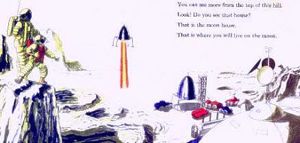 | On the Moon Typical inner page of the primer You Will Go to the Moon. The 'dish-holes' are called 'craters'... |
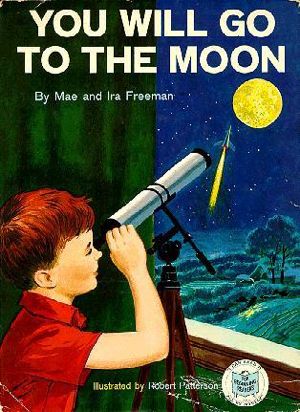 | You Will Go Cover of You Will Go to the Moon. But we didn't! |
 | Rollout of W-1 Weltraumschiff 1 Startet! |
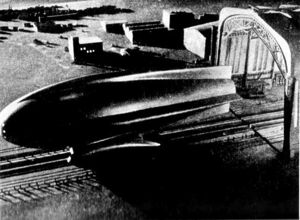 | W-1 on launch rails Weltraumschiff 1 Startet! |
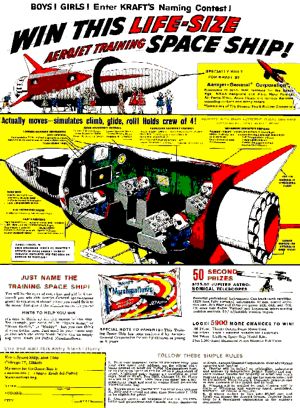 | Kraft Spaceship This ad - on the back of most comic books in 1959 - gripped the imagination of a generation. Who would win the prize? |
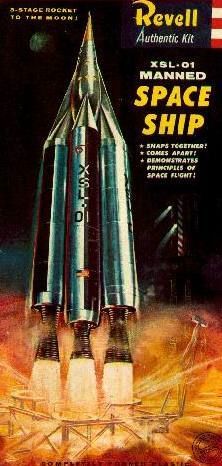 | XSL-01 Revell's fabulous XSL-01 model, which 'demonstrated the principles of spaceflight'! |
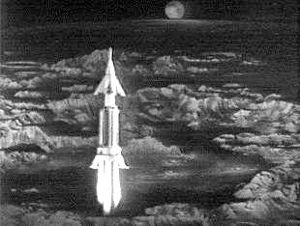 | Men in Space The lunar lander heads for the lunar surface. |
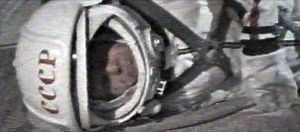 | Soviet Moon Lander The first man on the moon - a Soviet, dead on the surface a little way from the wreck of his lunar lander, from the film 'Countdown' |
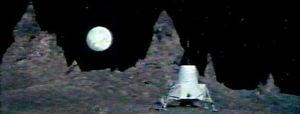 | Lunar Gemini Lunar Gemini on the moon - scene from the film 'Countdown'. |
Back to top of page
Home - Search - Browse - Alphabetic Index: 0- 1- 2- 3- 4- 5- 6- 7- 8- 9
A- B- C- D- E- F- G- H- I- J- K- L- M- N- O- P- Q- R- S- T- U- V- W- X- Y- Z
© 1997-2019 Mark Wade - Contact
© / Conditions for Use